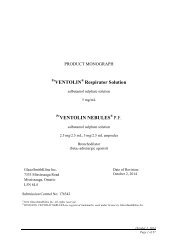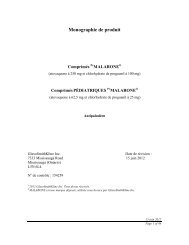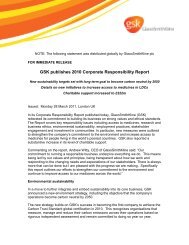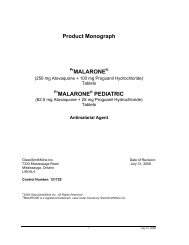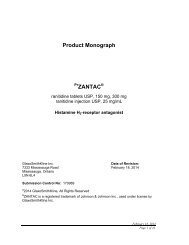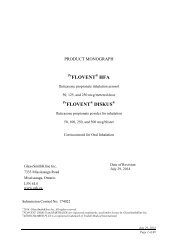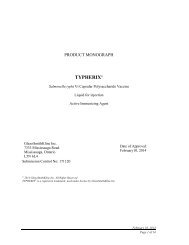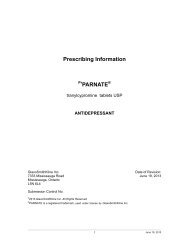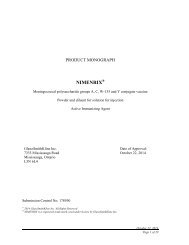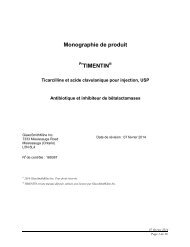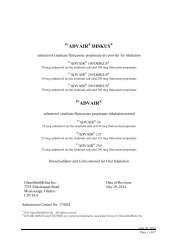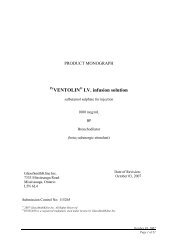PRODUCT MONOGRAPH IMITREX DF IMITREX ... - GlaxoSmithKline
PRODUCT MONOGRAPH IMITREX DF IMITREX ... - GlaxoSmithKline
PRODUCT MONOGRAPH IMITREX DF IMITREX ... - GlaxoSmithKline
Create successful ePaper yourself
Turn your PDF publications into a flip-book with our unique Google optimized e-Paper software.
A long term repeat-dose subcutaneous study of 24 weeks’ duration was performed in theBeagle dog at doses of 1, 3.5 and 12 mg/kg/day. Injection site reactions included edema,marked hemorrhage, moderate/chronic inflammation and minimal arteritis. Someminimal injection site changes were also seen in treated animals after a 5-week recoveryperiod.Transient dose-related changes in the precorneal tear film of treated dogs were observed.There was, however, no histological evidence of damage to the cornea or surroundingtissues.Analysis of hematological parameters revealed a slight lowering of some red cellparameters in the high-dose (12 mg/kg/day) group. No reticulocyte response wasevident. Although no effect on total leucocyte count was observed, lymphocyte numberswere generally lower and neutrophils were generally slightly higher at this dose level.The only change observed during the recovery period was a statistically significantlyreduced hemoglobin level in the males.CarcinogenicityThe carcinogenic potential of sumatriptan was evaluated in a 78-week oncogenicity studyconducted in mice given oral doses of 10, 60 and 160 mg(base)/kg/day. There were twogroups (102 mice each) given the vehicle only.Tumours were found in more than half of the male mice and in less than half of thefemales across all groups. There was a statistically significant increase in the incidenceof non-fatal hemolymphoreticular tumours observed in males at the dose of 60 mg/kg/daygroup only when compared with controls. Since there was no dose relationship, thisincrease was considered to be of no toxicological significance. There was no evidencethat administration of sumatriptan at any of the dose levels caused any alteration in theincidence of any specific tumours or non-neoplastic lesions.A 104-week study was conducted in the Sprague-Dawley rat given oral doses of 10, 60and 360 mg(base)/kg/day. Two control groups of 100 animals each were given vehiclecontrol only.There was a significant increase in the incidence of non-fatal adrenal medullary tumours(benign and malignant pheochromocytomas) in males given doses of 10 and60 mg/kg/day and in males dosed at 360 mg/kg/day. A significant increase in theincidence of benign testicular interstitial (Leydig) cell tumours occurred when comparedwith controls. Adrenal medullary tumours also increased significantly in females dosedat 60 and 360 mg/kg/day. Comparison of both types of tumours with historical controldata indicated that the observations were within the expected background range for thespecies and that long-term exposure to sumatriptan does not induce any treatment-relatedincreases in the incidences of any tumours for the species tested.October 21, 2014Page 36 of 58



